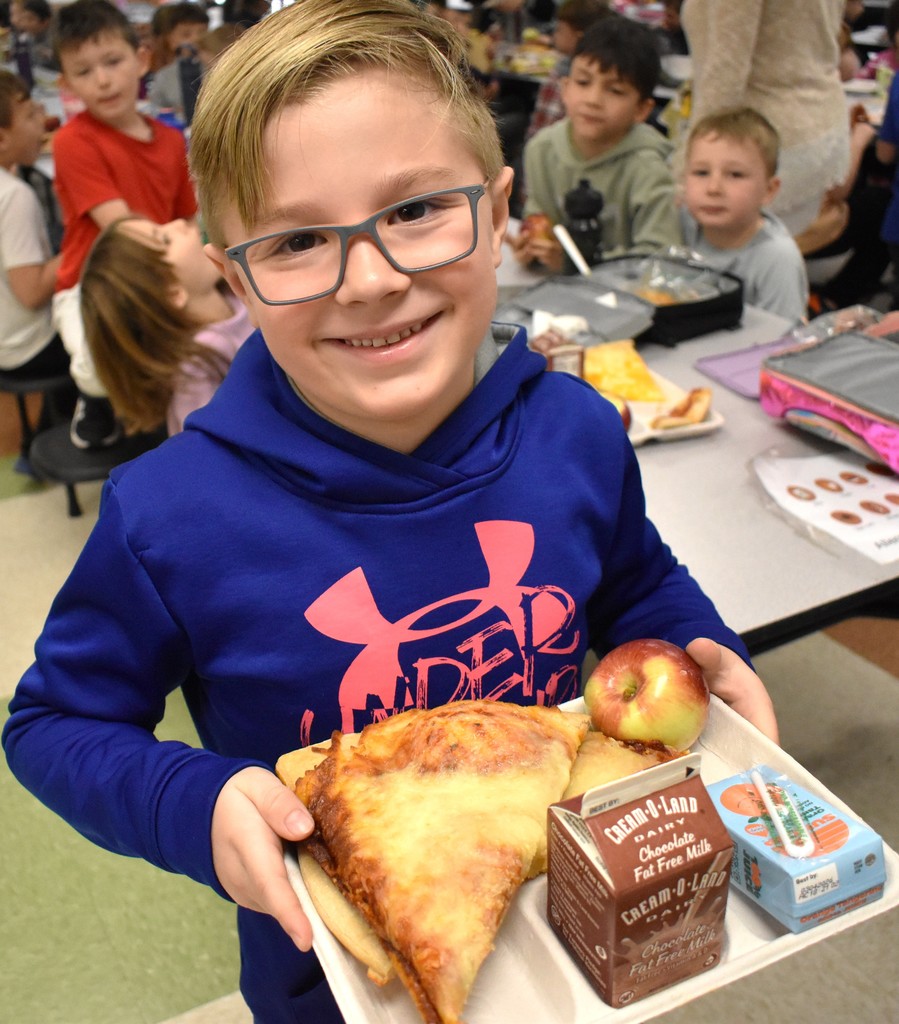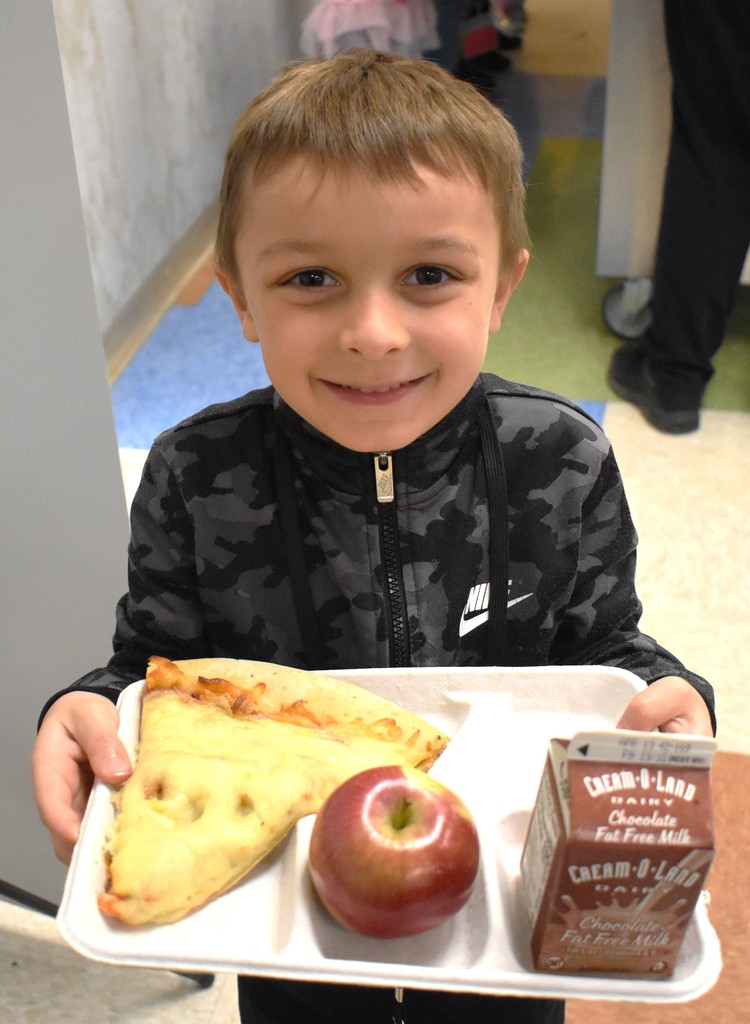The Middle School’s Minisink Motivates Club recently traveled up to the Elementary School for their second annual reading of the "Weird" series by Erin Frankel to second-grade classrooms. Middle schoolers read a story from the series and then completed an activity with students. It’s another great example of positive inter-school relationships!
Middle school students and elementary school students had a great time interacting with one another and completing the activity. Take a peek at this wonderful example of inter-school cooperation and relationships!
In one book read to some students, Luisa gets made fun of for her polka dotted boots. She comes to find that they are just one thing that makes her unique. Students used a chart paper in the shape of a rain boot and received two polka dots. They decorated one in their own creative way. On the other one, they wrote something that makes them unique or something nice about themselves. Each of the students' polka dots were put onto the poster as a reminder of how special they are.
Other students were read a book about Jayla, a bystander who gets involved in a way that she isn't proud of. She is "dared" to do things that are unkind. Jayla is very interested in the solar system and even does a project on it. Each of these students were given stars to decorate and write on to put on a solar system poster.
Lastly, some students were read a book about Sam, the story’s bully. Students learned where her bullying behavior stems from. She loves to play guitar so the students put hearts on a guitar poster, which also included decorating one and writing a note on the other.
“No matter which book they were read, the message ended up being the same,” said co-advisor Lauren Pullen. “Everyone deserves to be accepted and know that they are special in their own way. After reading, our members helped each of the second-grade students talk about, identify, and write qualities that make them feel special. Our hope leaving this visit is always that students understand the importance of accepting and celebrating others for who they are, as well as loving themselves for what makes them different.”










District kindergarten students, like Tiffany Guareno’s ES kindergarteners, are learning about “teen” numbers. They’ve have already mastered counting up to 20 and are now working on counting out groups of 11 through 20!
In order to do this important work, they’re being taught to model a “teen” number as “10 ones” and “some more ones.” During this recent lesson, they had the opportunity to visit a rekenrek (a rekenrek is a counting frame, often used in math education, that consists of two rows of beads), a beans and egg carton and a cubes station. Students were given a “teen” number and had to represent their number as “10 ones” and “some more ones” at each station! Take a peek!
Learning "teen" numbers (11-19) in kindergarten is crucial for building a solid math foundation. It helps children understand the concept of place value, which is essential for later mathematical concepts like addition, subtraction, and understanding larger numbers. It also helps them develop number sense, which involves understanding the relationships between numbers and quantities.








Last evening's K-12 Art Show was beyond beautiful! It was bright, colorful, unique creative and full of pride by everyone who attended! We hope you were there!
Take a peek at some of our proud student-artists who were thrilled to show their works of art. Did you know that approximately 1,000 students had at least one piece of art on exhibit? THANK YOU to our awesome art faculty in our five buildings for their work to stage such a gorgeous exhibit! We appreciate you! See more photos on the district's Facebook page: https://www.facebook.com/MinisinkValleyCSD










THANK YOU to everyone who played a role in the success of the Elementary School's annual Transportation Day, held this past Friday ! Our youngest students had the wonderful opportunity to explore these vehicles which make so many important contributions to our communities...plus meet a K9 dog, too! It was a great educational opportunity! Take a look! As always, we're grateful to the Elementary School PTO for organizing a wonderful experience for our young students! See more photos on the district's Facebook page: https://www.facebook.com/MinisinkValleyCSD









CAN YOU HELP?
Mark your calendar, ONE WEEK FROM TODAY!
Giving back has never been cooler! Join us at Rita's on Dolson Avenue on Thursday, May 22 from 5 to 8 p.m. for a refreshing ice or custard and a portion of your money spent will go to the Tyrell J. Audian Memorial Scholarship at the High School!
TJ was a 2019 graduate and dedicated his life to our nation by enlisting in the Marines right out of high school. Tragically, TJ suddenly passed away during a training exercise with his unit. A track scholarship in his honor has been created in collaboration with High School yearbook. Please consider supporting of this worthy cause!

The Elementary School team completed kindergarten screening earlier this week! They met some adorable incoming students who were proud to share what they know!
The purpose of a screening is to ensure a child is developmentally ready to start kindergarten and may determine whether any additional classroom support may be needed. Screeners look at basic kindergarten readiness skills, including: language, cognitive, gross and fine motor skills. It’s also a great way for us to meet our new students! PLUS: Our soon-to-be students also got a chance to take a short ride on a school bus…how fun is that?






Kimberly McDermott’s ES second-graders and Lindsey McKernan’s ES kindergarteners recently gathered to teach their young students about composting with worms!
Mrs. McKernan recently taught a unit on taking care of the earth to her kindergarten students, where they learned to reduce, reuse and recycle. To culminate the unit, Mrs. McDermott's second-grade class invited Mrs. McKernan's kindergarteners to learn about creating a compost bin ...complete with live red worms!
How fun is this? The second-graders took turns teaching the little kindergarten students facts about composting with red worms. Then, these kindergarteners got a chance to hold the worms! (Who doesn’t love holding worms?)
Finally, Mrs. McDermott shared some red worms with Mrs. McKernan and the kindergarten students started their own composting bin!
What a great intra-school STEM lesson which also teaches students about environmental responsibility, the natural cycles of life, and how to reduce waste. It provides a hands-on learning experience that helps them understand decomposition, soil health, and the importance of recycling.







MARK YOUR CALENDARS NOW!
One of the biggest district-wide events will take place Tuesday, May 20: The annual annual District Art Show/K-12 Exhibition! Over 400 student artists representing the High School, Middle School, Otisville Elementary the Intermediate School and the Elementary School will have work on display from 5 to 8 p.m. at the High School cafeteria and auditorium. It's always a gorgeous and vibrantly colorful exhibition, featured all kinds of art mediums! This exhibition is equally wonderful because of the smiles on the proud families and students! Please join us!

Congratulations to the 17 students who were recognized at the NYSAHPERD Catskill Zone Leadership Awards Ceremony, held this past Saturday at Wallkill High School!
This event honors top-grade-level students who exemplify excellence in fitness, leadership, and citizenship—key components of New York State learning standards.
These students were selected for their commitment to an active lifestyle, responsible behavior, leadership qualities, and contributions to their school community. While athletic ability is not a requirement, each honoree embodies the spirit of personal growth and positive influence.
"These students are role models who lead by example, showing us the power of character, effort, and service in physical education and beyond,” said Physical Education teacher Theresa Uhelsky, the organization’s past president.
Students honored were:
Middle School
• Mason King
• Ben Ziegler
• Lennox Addo
• Erin Arias
• Lyla LeBarbera
Otisville Elementary
• Leah Galligan
• Quinn Lattimer
• Luca Artola
• Eliya Graziano
Intermediate School
• Ella Manzie
• Madison Worden
• Jemma Marsala
• Charlotte Kohler
Elementary School
• James Santos
• Gary Boyajian
• Declan Barry
• Kaylee Jackler





¡Buenos días! Meghan Donahue’s ES first-graders spent some time yesterday learning about Cinco de Mayo and afterward, had the very cool opportunity to help prepare fresh guacamole!
In addition to learning about Cinco de Mayo, students learned that an avocado is a fruit! Botanically, it's classified as a single-seeded berry. While it's often used in savory dishes and considered a vegetable in some culinary contexts, its development from the ovary of a flowering plant and the presence of a seed make it a fruit.
Students used their five senses to describe avocados on the outside and inside, including tasting them! After exploring avocados, students followed a sequence of steps and directions and learned about authentic Mexican ingredients to make the perfect guacamole for their Cinco de Mayo treat! What a great history, science, culinary and multi-step direction lesson!
•Cinco de Mayo, which means "Fifth of May" in Spanish, is a holiday celebrating the Mexican army's victory over the French at the Battle of Puebla on May 5, 1862. While it's often mistaken for Mexican Independence Day, it's actually a celebration of Mexican pride and the courage of the Mexican army.
•In Mexico, Cinco de Mayo is more of a regional celebration, especially in the state of Puebla, where the battle took place. Celebrations are also seen in other Mexican regions, like the Peñon de los Baños neighborhood of Mexico City. However, it's not a national holiday, and most businesses are open.
•In the United States, Cinco de Mayo has evolved into a more widespread celebration of Mexican culture, with parades, festivals, and celebrations featuring Mexican music, food, and traditions.
•The main ingredient in guacamole is avocado, which is mashed and then mixed with other ingredients like lime juice, salt, and sometimes cilantro, onion, and jalapenos. While the avocado is the core component, other flavors like onion, tomato, garlic, and spices like cumin can be added for a more complex flavor profile.









Meghan Donohue’s ES first graders, like other district first-graders, have been learning about the difference between living and non-living things.
They know that living things move, change and grow…and even if they can’t see it in “real time,” plants are constantly moving, changing & growing, just like they are!
Students have also learned about the life cycle of plants, and what’s needed for them to survive. They put their knowledge to work by starting a class garden! Students followed a sequence of steps to ensure their planting process was perfect and are looking forward to seeing their flowers bloom soon!
Like their peers in other ES first-grade classes, students also have some new “class pets”: LADYBUGS!
Classrooms are now homes to a growing population of ladybug larvae. Students continue to observe them in the early stages of life, and are anxiously awaiting the next stage in the ladybug life cycle. Thus far, students have observed their baby bugs in the larva stage, their second stage of life. Next up will be the pupa stage, followed by emerging ladybugs!








MORE BOWLING FUN!
Anthony Pascarelli’s ES physical education kindergarteners are having a blast learning about bowling!
They understand what a “strike” and “spare” means and are learning proper bowling form in class! Take a peek!
Bowling offers numerous benefits for kindergarteners, fostering physical, mental, and social development. It improves hand-eye coordination, balance, and strength, while also developing focus, patience, and social skills like teamwork and sportsmanship. Bowling also subtly builds analytical skills through calculating scores and understanding angles.


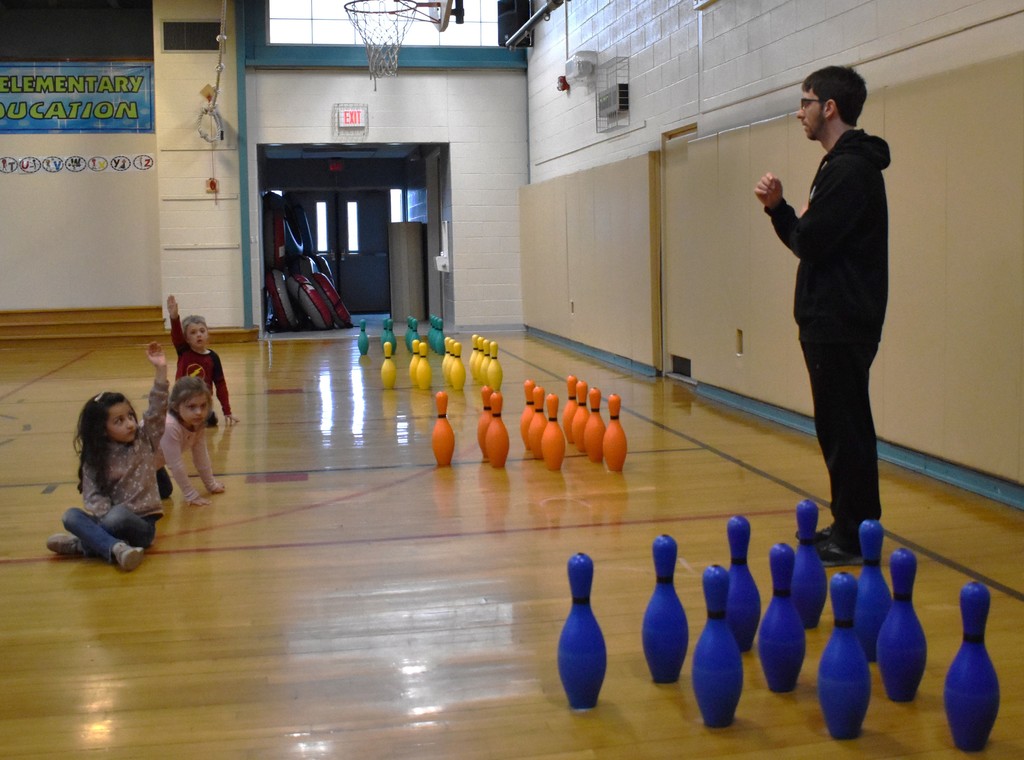



TODAY IS ARBOR DAY --- the day that celebrates planting trees! To help mark this annual day, Elementary School first-graders attended a special assembly earlier this week featuring guest speaker and certified arborist Mark Beamish of Orange & Rockland Utilities.
Mr. Beamish spoke to these young students about many different tree facts. For example, students learned that deciduous trees have leaves that grow in the spring and fall in the winter and grow in a round shape. In contrast, coniferous trees have needles that stay green all year and grow in the shape of a pyramid.
PLUS: Every first-grader went home with a coniferous tree sapling to plant at home! Coniferous tree saplings to promote reforestation efforts, enhance wildlife habitat, and provide aesthetic and environmental benefits. Conifers, with their year-round greenery, offer windbreaks, shade, and contribute to soil health. They also provide shelter for birds and other animals. THANK YOU, Mr. Beamish!
Arbor Day is a national holiday dedicated to celebrating and promoting the importance of trees and tree planting. It encourages communities to plant trees and learn about their benefits, with the first Arbor Day celebrated in Nebraska in 1872.

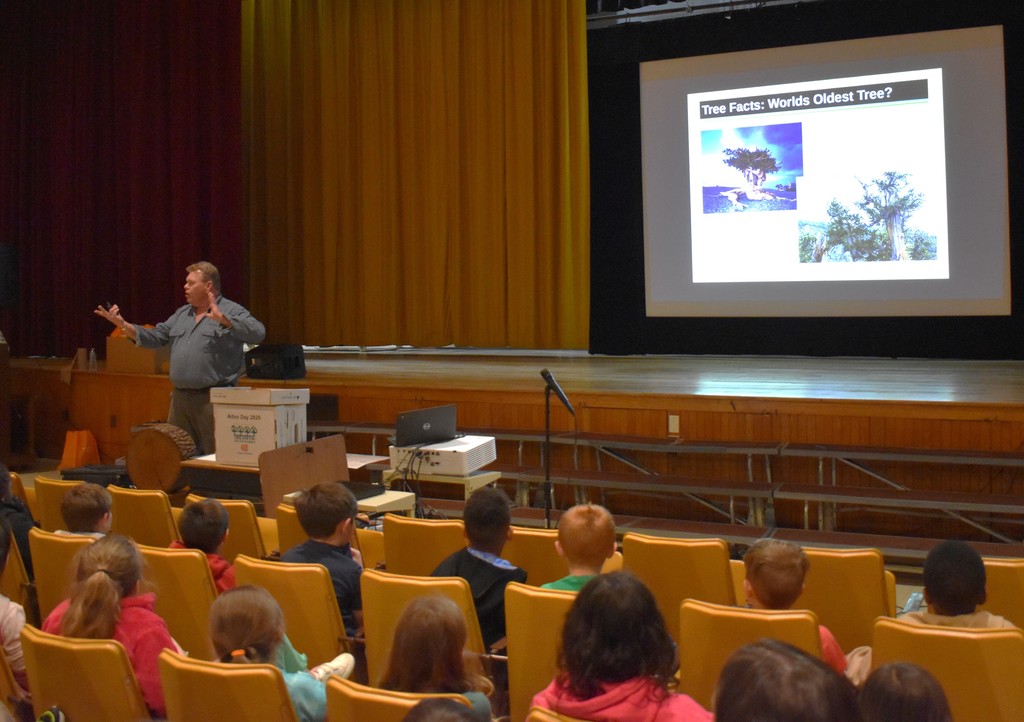
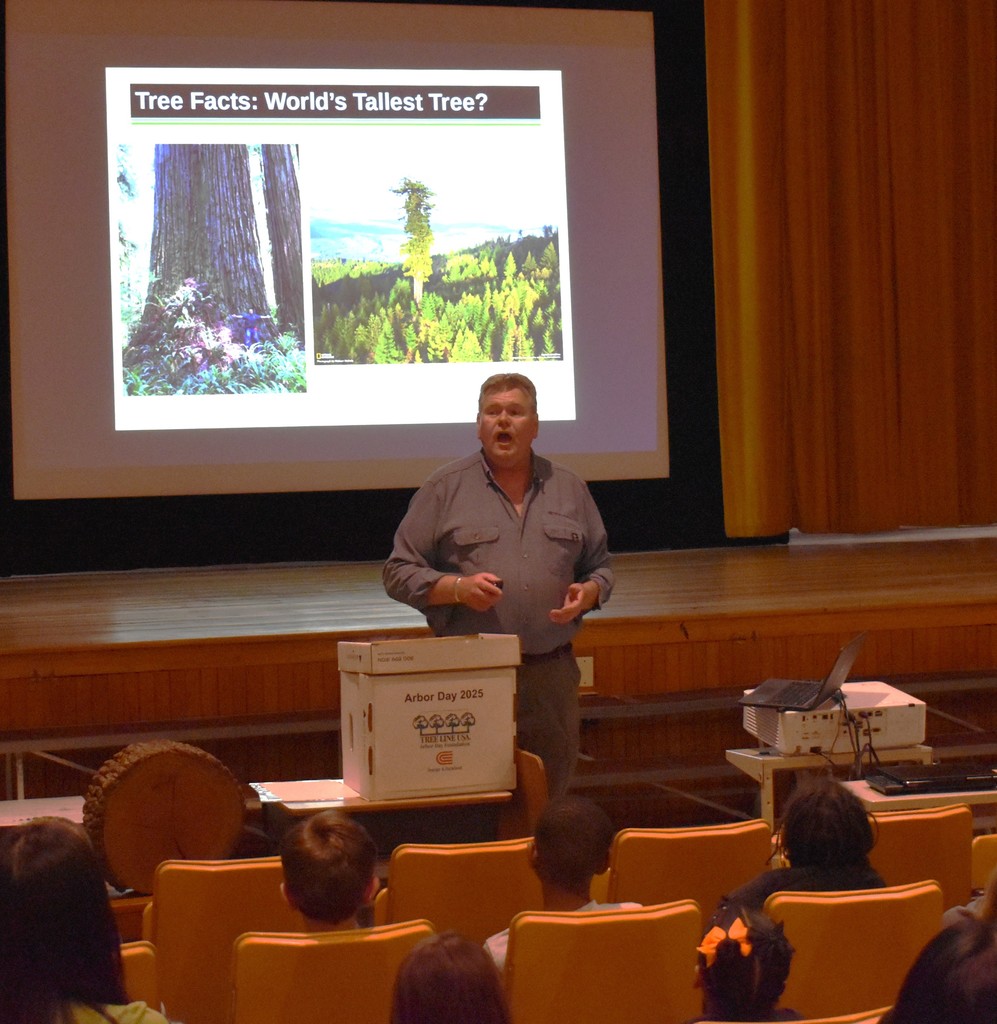
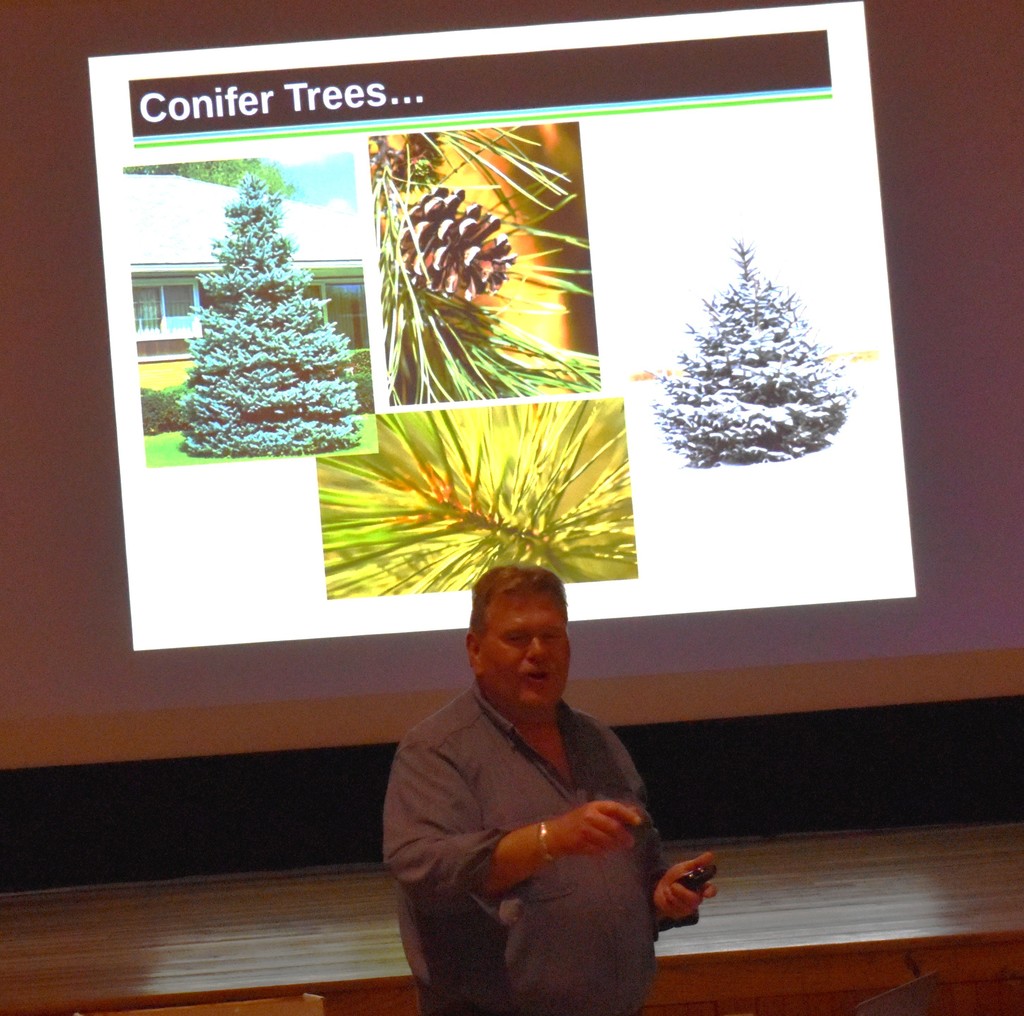
ADORABLE! Before the break, Carmela Sill’s/Stephanie Ewanciw’s ES kindergarteners had some special visitors! Mrs. Ewanciw’s bunnies, “Oreo,” “Marshmallow,” “Chocolate Chip” and “Rosemary” spent the day in class and mesmerized these little students with their cuteness!
In addition to tying into the seasonality of spring, students also had a fun lesson learning about bunny care. Students learned that bunnies need a safe and stimulating environment to live in, with a lot of space to move around; and it’s important for them to have a balanced diet of mostly hay, fresh greens and water (just like children need a balanced diet every day!)
And… they also learned bunnies need a variety of toys like stacking cups and chewing materials to keep them mentally and physically stimulated. They were also surprised to learn that bunnies can be trained to use a litter box, just like cats!




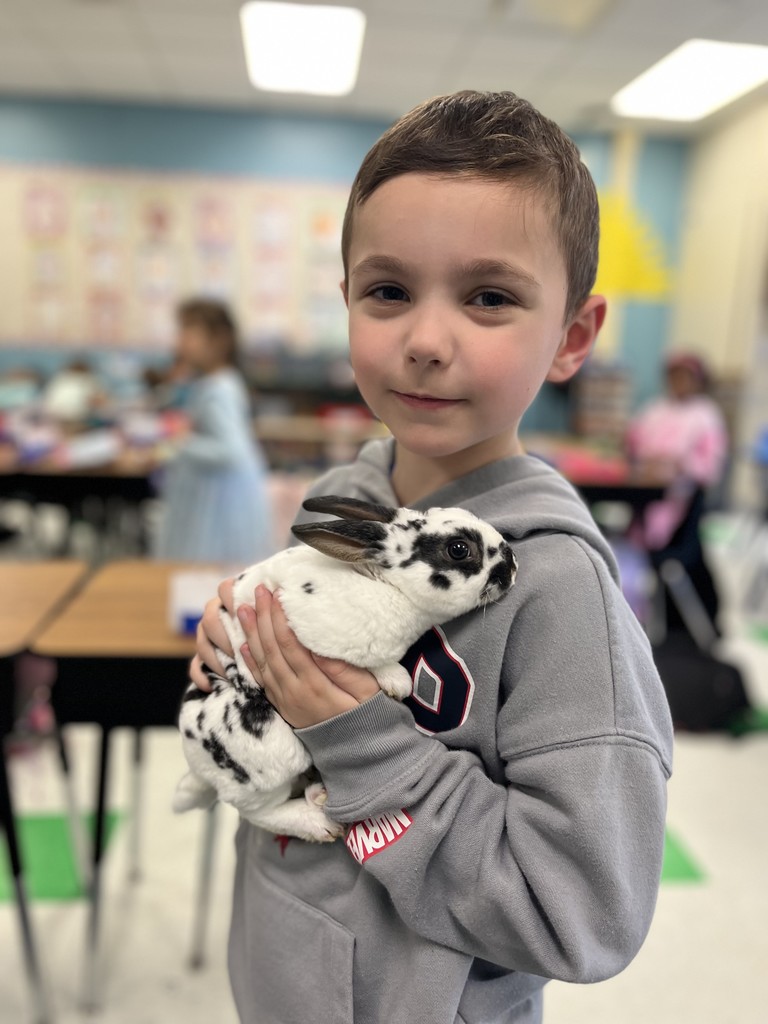
COMBINING EARTH DAY FUN AND IMPORTANT LESSONS!
Marjori Bobish's ES transitional kindergarteners, like many students districtwide, spent time learning about why Earth Day, which was April 22, is an important day to commemorate!
These cutie-pies made adorable Earth Day art projects and spent time time outdoors showing why they "Care for our Earth" by helping to clean-up outside! We appreciate their outdoor help!
Celebrating Earth Day gives students of all ages a chance to foster a sense of environmental responsibility and connect them with the natural world. This learning helps them develop a deeper appreciation for the planet and inspire them to become environmentally conscious citizens in the future.

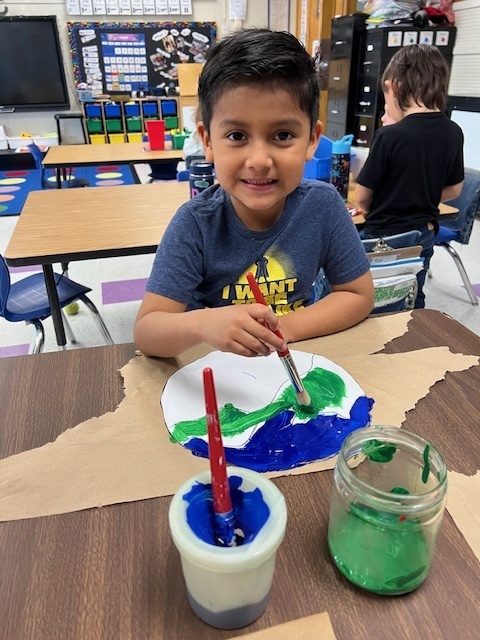







Megan St Clair’s and Sarah Kocot’s ES second-graders, like all district second-graders, have been learning about the human body and many of its organs. In this recent and amazing lesson, students first worked with a miniature skeleton to place the organs they were learning about in the correct position.
Later, their teachers incorporated a fun art component to this science lesson by creating student-sized body outlines! In five different groups, students took what they learned on the smaller skeleton and correctly placed organs on the outlined body, labeling each organ. Each “body” was distinctively unique, with each group’s creativity giving their “body” its own personality!
Plus, a byproduct of this lesson was students had the opportunity to work in groups! Group work allows them to learn to share ideas, listen to others, and work collaboratively, which are valuable skills for both school and real-life situations. It also encourages critical thinking and problem-solving as they discuss and evaluate information together.

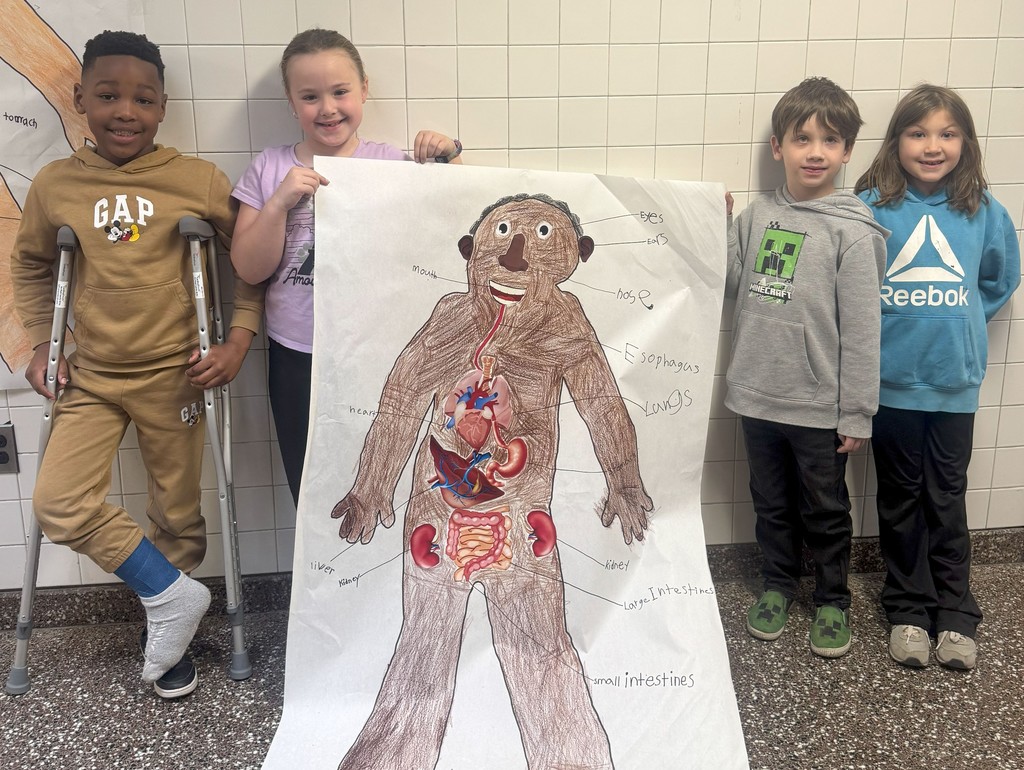
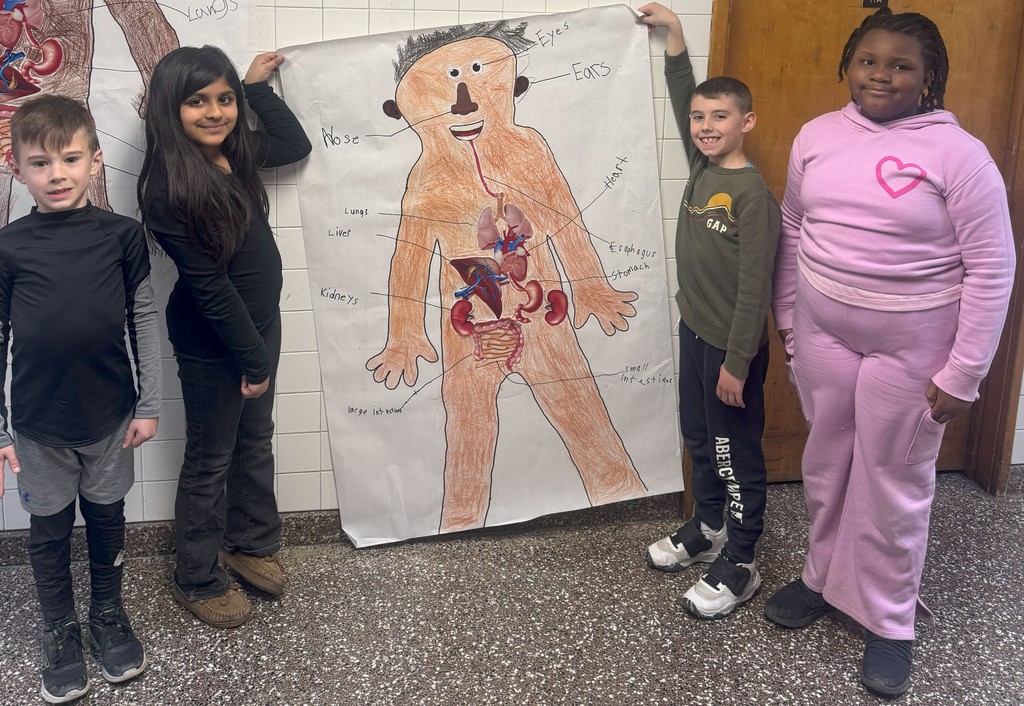




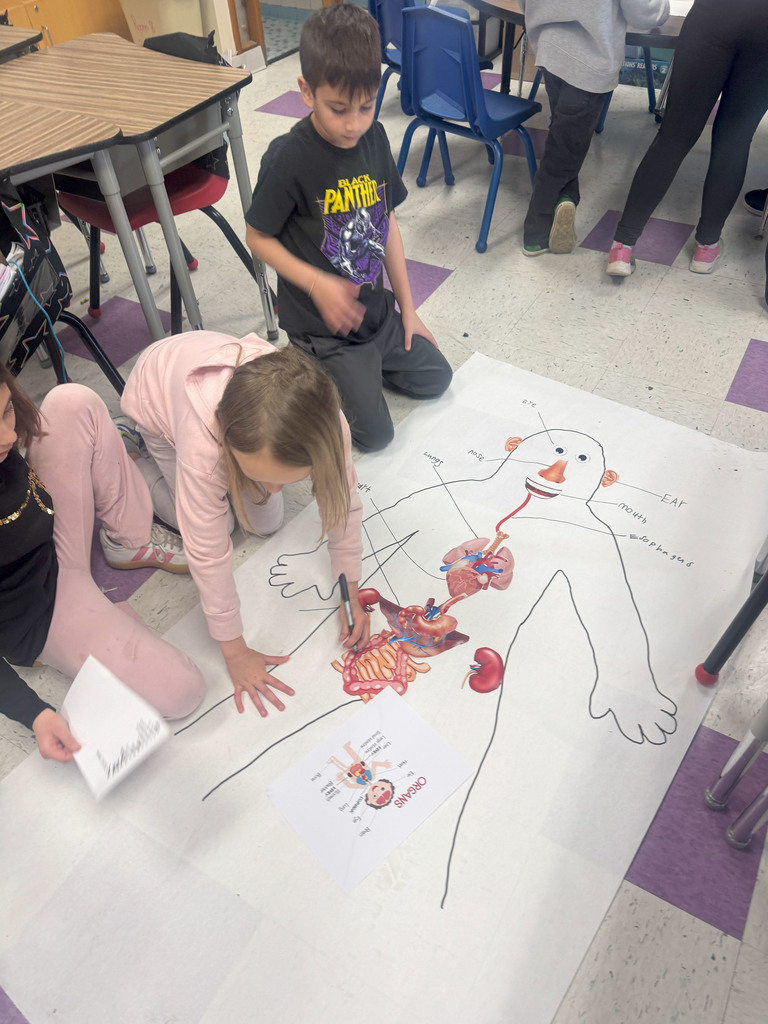
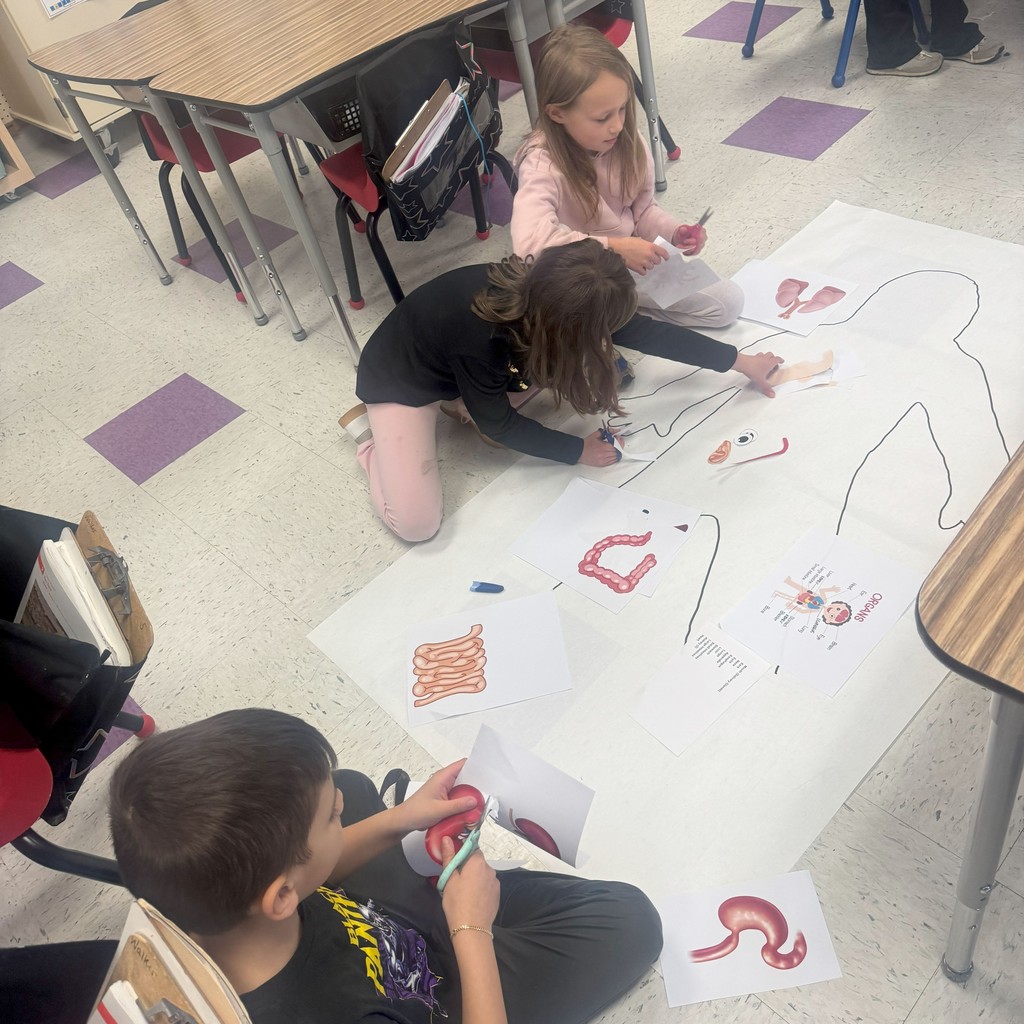

MORE HANGING WITH THEIR PEEPS!
Before the break, Shawne Demberg’s ES kindergartners learned a great deal about responsibility by caring for their PEEPS! Some of their tasks included keeping their personal PEEP safe, reading it a bedtime story and bringing it to and from school each day. They became stellar caregivers and had great lessons in learning about why caregiving is so important! Even therapy dog Addy was a great assistant, serving as a babysitter when the students left the room! Well-done, everyone!








HANGING WITH THEIR PEEPS
Before the break, Gemma Lyon’s ES second-graders explored PEEPS, those seasonal sugary sweet springtime treats we’ve all eaten, in a day full of fun ELA and science work! TAKE A PEEP….rather, PEEK!
Students completed multiple science experiments using their senses and incorporated new vocabulary words called “prediction” and “observation” into their expressive and written language. They even had some fine motor skill practice creating and decorating a special PEEP “house!”
Each student also adopted a PEEP and took their PEEP on some adventures over this past spring break! Mrs. Lyon is looking forward to hearing about the adventures and reading their journals now that her students are back in class!
•Just Born, the company that makes PEEPS Brand Marshmallow candies, produces enough in one year to circle the Earth twice.
•Yellow is America’s best-selling color of PEEPS chicks and bunnies.
•Yellow and white PEEPS chicks and bunnies came first, followed by pink, lavender, blue, green and orange.





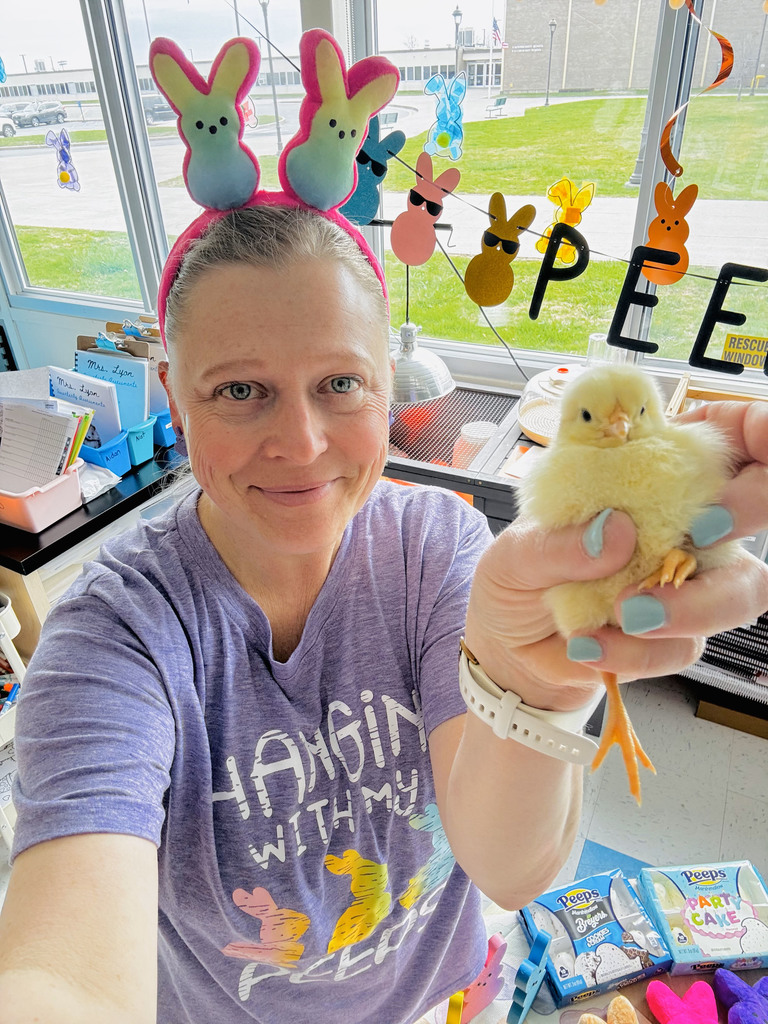



Reminder: The 2025-26 student calendar has been available for everyone's use!

Our youngest students always have big smiles on Fridays at lunch time, as it's PIZZA DAY! Our dedicated Food Services team prepares homemade pizza for all who are interested! (You can smell it being prepared in the hallways, too!)
Take a peek at our youngest ES students with their traditional, pepperoni or "grilled cheese" slice options! Remember, everyone eats from free! (But, some student families do put funds in their children's "My School Bucks" accounts to purchases extras, like ice cream, or on pizza days... an extra slice!)
